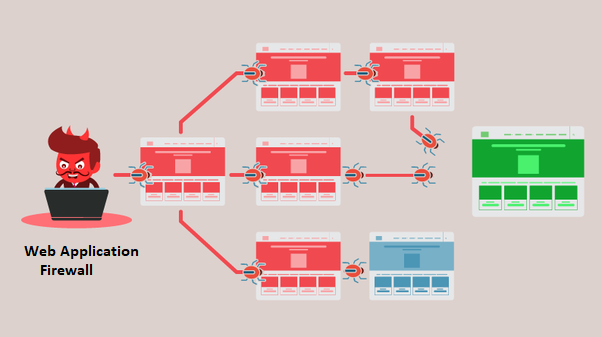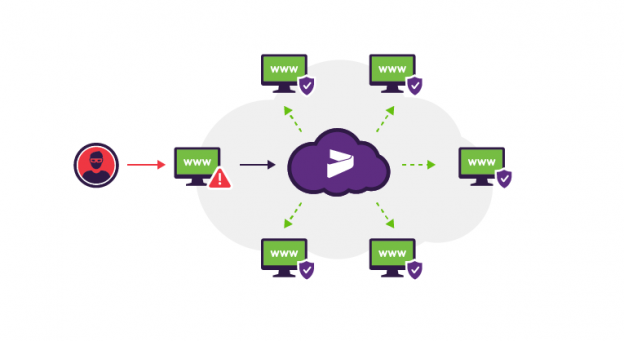With the deployment of a strong web application firewall, one can be ensured and secured for critical web applications wherever they reside such as within a virtual software-defined data center (SDDC), managed cloud service environment, a public cloud, or traditional data center. A powerful WAF solution contributes towards organizations to protect against OWASP top ten threats, various application vulnerabilities, and zero-day attacks.
There are many organizations, which deliver updated rich and complex web content to customers without having an adequate security measures and which inculcate significant risks and are exposed to many potentially malicious attacks from frequently changing IP addresses. A powerful WAF also allows compliance with some key regulatory standards like HIPAA and PCI DSS.
In today’s era, enterprises are exploring their businesses with the usage of more web-based along with cloud-hosted applications, so a more powerful web application firewall (WAF) isn’t a luxury—it’s a requirement, a need.
At present, these cloud-based applications have become very popular, and so such malicious attacks have increased tremendously thus threatening enterprise data. This particularly makes it far more complicated for administrators and various security teams to keep in check with these latest attacks and protection measures. Also, meanwhile, the various security teams ought to meet the compliance requirements for the purpose of data sharing and online commerce across various traditional and cloud environments.
 Here’s a checklist of some of the key factors that you must keep in consideration when selecting a WAF for the protection of your enterprises:
Here’s a checklist of some of the key factors that you must keep in consideration when selecting a WAF for the protection of your enterprises:
• Deployment Models
Various enterprises might continue for the usage of a hardware WAF appliance to protect their critical applications which are managed in a traditional data center. They can also obtain their application related security requirements using other WAF deployment models. Traditionally, the concept of WAF was deployed as hardware appliances on premises in various enterprise data centers. But with the migration of applications to cloud-based Infrastructure-as-a-Service (IaaS) environments and organizations leveraging cloud Software-as-a-Service (SaaS) apps, administrators and security teams are challenged for protecting applications beyond their data center. That means they cannot compromise on factors like performance, scalability, and manageability. Organizations usually struggle quite a lot to keep in check and maintain required control over new enterprises which offers limited security options for critical web applications residing beyond the controlled environment.
• Network Architecture and Application Infrastructure
In this specific inline model, there are three very significant methods that can be used to pass and control traffic: reverse-proxy mode, router mode, and bridge mode.
– Reverse proxy is the most common and used mode of operation. It basically works by terminating all incoming traffic and doing interaction with the server on behalf of a requestor. Reverse-proxy is the Go-To mode for security capabilities.
– Router mode is quite similar to reverse proxy mode, but it does not work by terminating requests intended for the server and actually offers few services. It is also called transparent mode. Frequently, transparent mode usage id conducted for traffic logging along with reporting.
– In bridge mode: In this mode, the WAF functions as a layer 2 switches with a very defined and limited managed firewall services.
Technically, the mode of operation will be determined by knowing how the application is basically set up on the network. Thus, before opting for a WAF, we must carefully consider various deployment option that suits best for the network infrastructure and network environment, and must understand the scope of services that one will need to use.
• Security Effectiveness and Detection Techniques
Traditionally, the most popularly used WAF configuration is a negative security model, which basically enables all the possible transactions except those that contain a malicious threat or attack. Both positive and negative models are capable enough of obtaining the delicate balance between “security” and “functionality.” In recent decades, positive security models have become more popular. This security approach blocks maximum traffic, allowing only such transactions that are known to be safe and without threat. The concept is based on strict content validation and statistical analysis. However, none of these alone can deliver the most effective and economical solution in every environment.
• Performance, High Availability, and Reliability
Read More at : Multi-faceted Advantages of Web Application Firewalls
WAF should include following features that address these factors directly:
– Burden on back-end web servers is reduced by Hardware-based SSL acceleration.
– Performance is optimized by Load balancing web requests across multiple back-end web servers
– Efficient network transport is offered by automatic content compression.
– Back-end server TCP is reduced by connection pooling which is done by enabling requests to use same connection.
– Virtual Patching and Scanner Integration.
Web application malicious attacks or vulnerabilities are usually the most common causes of data breaching. Enterprises with a WAF can easily detect any malicious attacks and provide a solution by providing virtual patches. Virtual patches are basically fixes for vulnerabilities for preventing various cyber exploitation by hackers and attackers. However, developers and programmers put their best practices in secure coding, and might ensure adequate security testing of such applications, but all applications are somehow prone to vulnerabilities. Fixes doesn’t requires any immediate changes to the software, and it allows various organizations to secure applications. Various malicious attacks and exposures which are specific to each application make companies web infrastructures exposed to vulnerabilities such as cross-site scripting, SQL injections, cookie poisoning, and others. Virtual Patches comes with automatic attack detection and anti-fraud capabilities.
• PCI DSS Compliance
The PCI DSS requirements are being efficiently revised in a security attempt to avoid any malicious attacks and keep user’s data secure. Various malicious attacks are manufactured to steal sensitive credit card information. At present era, more and more security breaches and data thefts are occurring regularly. So, if in case your organization works with sensitive credit card information, you must attempt to comply with PCI DSS requirements. Web applications must be strengthened for protection with security purposes, they are often pathways for vulnerable malicious attackers to obtain wrong access to user’s sensitive cardholder data.
Read More at : Key Aspects of Web Application Firewalls that Should Never be Ignored
• Visibility and Reporting
Along with protecting the firewalls, this helps an organization to collect and analyze the data securely so that it has a better understanding of the current threat landscape—and gives a picture of how secure your applications are.
It provide reports on various web-based attempts to obtain access to user’s sensitive data, might subverting the database, or executing DoS attacks against the database.
• Device ID and Fingerprinting
Browser fingerprinting basically grabs browser attributes in a motive to identify a client. This is basically a great feature to identify or re-identify a visiting user, user agent, or device. Such persistent identifications of a client is very significant, allowing tracking across sites.
However, it cannot be said that Fingerprinting-based identification is always reliable. It may not work with all device or browser types. It is advisable to check with your WAF vendor for a relying list of supported devices/browsers, specific features supported, a list of attributes etc.
• SSL Offload
The process of offloading SSL computation to other network resources basically allows various applications to dedicate significant CPU resources to other processing tasks, which are performance oriented. However, SSL processing can cause a strain on application resources. Firewalls which support SSL certificates offloading increases the utilization of the applications they protect, along with eliminating the need to buy additional hardware, and increase the value of the WAF itself.
• Behavioral Analysis
Behavioral analysis capabilities provides a helping hand and makes it easier for your organization to predict, easily identify, and respond to attacks. There are some WAFs that can analyze and understand volumetric traffic patterns. Also such WAFS scan for anomalous behavior based on some set of related rules. An excellent WAF will assesses average server response time, various transactions per second, and various sessions that request abundance of traffic for determining that whether an attack has taken place.
• Ease of Management
Earlier, in previous decades, deploying a Firewall used to be a somewhat difficult and time-consuming job as well for configuration and implementation of manual rules. Due to policy creation, firewalls can be processed with security policies that quickly addresses common vulnerabilities and exposure of attacks on web applications, including HTTP(S). Attacks. Management brilliantly compares the policies and provide a genuine evaluation of their functionalities across different firewalls, thus eventually strengthening overall security posture.
• Scalability and Performance
Organizations need to ensure about applications availability, even when they are under attack. It can provide the desired performance by optimizing applications and accelerating technologies like fast caching, compression, and TCP optimization. They are performance-oriented. The best WAF, with robust appliances and through centralized management, easily enables to handle large volumes of traffic.
• Vendor Release Cycle
It is advisable to enquire with your WAF vendor about their release cycle. As the threat landscape basically changes so quickly and dynamically, vendors that provides more common release, can help decrease your possibility of exposure and minimize the risk of your applications being compromised by a new or emerging threat.
Read More at : Key Indicators that Demand use of WAF for Enterprise Data Protection






 Live Chat
Live Chat